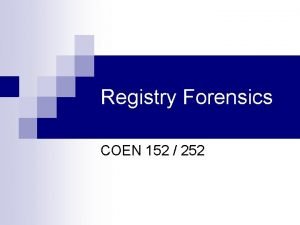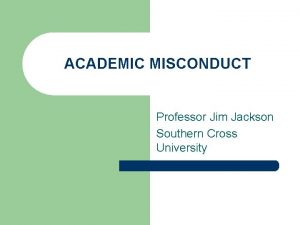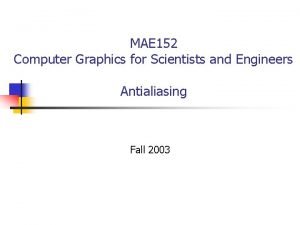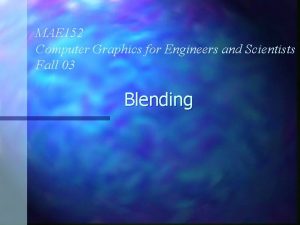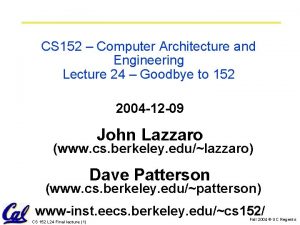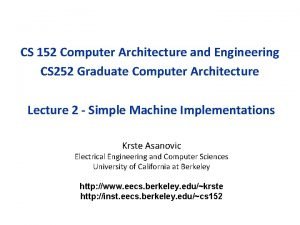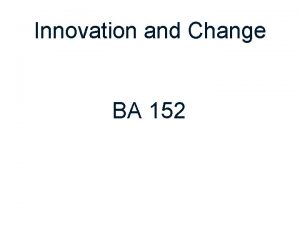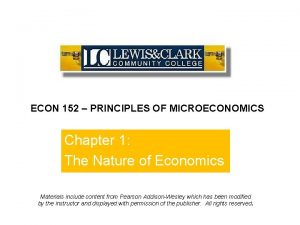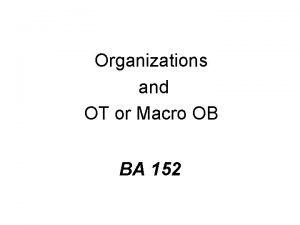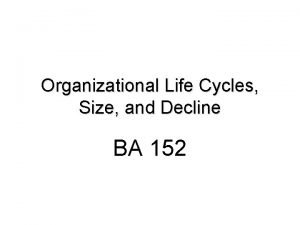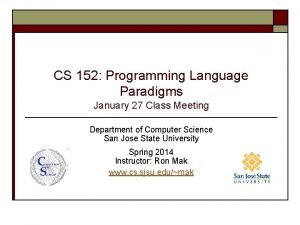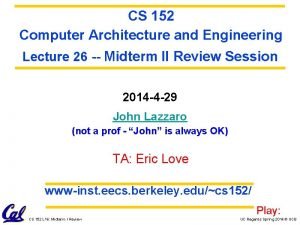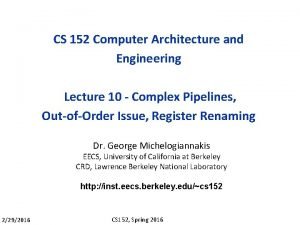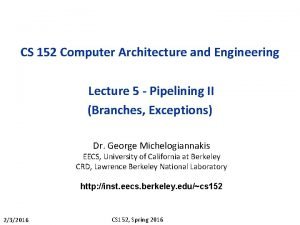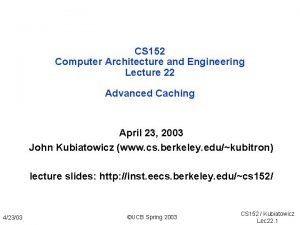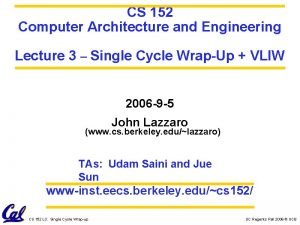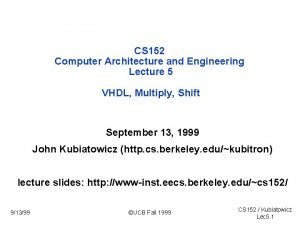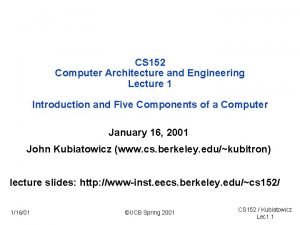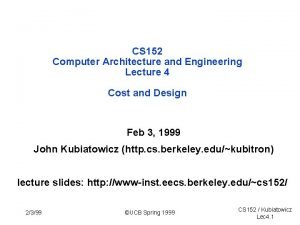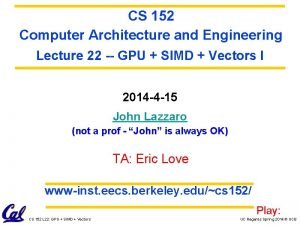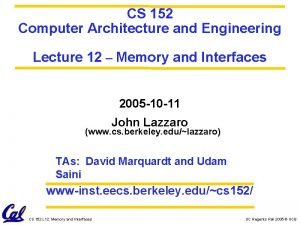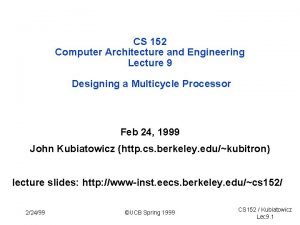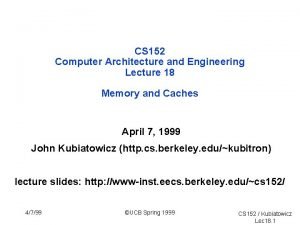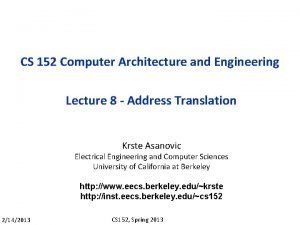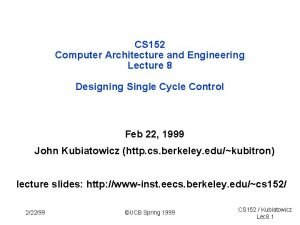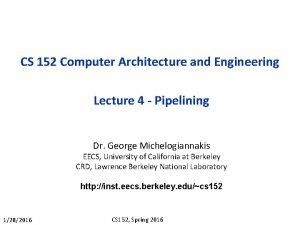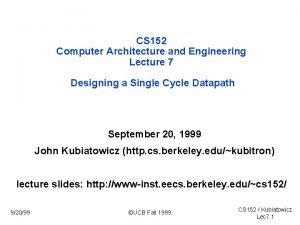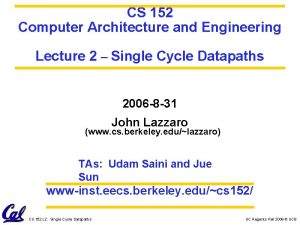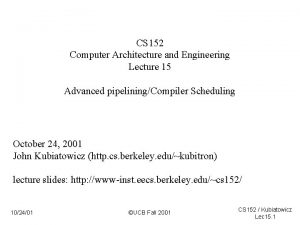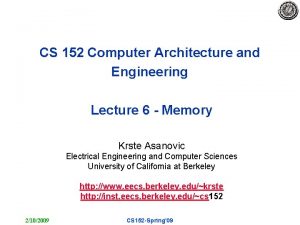CS 152 Computer Architecture and Engineering Lecture 19


















![Nonblocking Synchronization Compare&Swap(m), Rt, Rs: if (Rt==M[m]) then M[m]=Rs; Rs=Rt ; status success; else Nonblocking Synchronization Compare&Swap(m), Rt, Rs: if (Rt==M[m]) then M[m]=Rs; Rs=Rt ; status success; else](https://slidetodoc.com/presentation_image/5be6cb1188dca8551462f1489f4c4e50/image-19.jpg)











![N-process Mutual Exclusion Lamport’s Bakery Algorithm Process i Initially num[j] = 0, for all N-process Mutual Exclusion Lamport’s Bakery Algorithm Process i Initially num[j] = 0, for all](https://slidetodoc.com/presentation_image/5be6cb1188dca8551462f1489f4c4e50/image-31.jpg)

- Slides: 32

CS 152 Computer Architecture and Engineering Lecture 19: Synchronization and Sequential Consistency Krste Asanovic Electrical Engineering and Computer Sciences University of California, Berkeley http: //www. eecs. berkeley. edu/~krste http: //inst. cs. berkeley. edu/~cs 152 4/17/2008 CS 152 -Spring’ 08

Time (processor cycle) Summary: Multithreaded Categories Superscalar Simultaneous Fine-Grained. Coarse-Grained. Multiprocessing. Multithreading Thread 1 Thread 2 4/17/2008 Thread 3 Thread 4 CS 152 -Spring’ 08 Thread 5 Idle slot 2

Uniprocessor Performance (SPECint) 3 X From Hennessy and Patterson, Computer Architecture: A Quantitative Approach, 4 th edition, 2006 4/17/2008 • VAX : 25%/year 1978 to 1986 • RISC + x 86: 52%/year 1986 to 2002 3 • RISC + x 86: ? ? %/year 2002 to present CS 152 -Spring’ 08

Déjà vu all over again? “… today’s processors … are nearing an impasse as technologies approach the speed of light. . ” David Mitchell, The Transputer: The Time Is Now (1989) • Transputer had bad timing (Uniprocessor performance ) Procrastination rewarded: 2 X seq. perf. / 1. 5 years • “We are dedicating all of our future product development to multicore designs. … This is a sea change in computing” Paul Otellini, President, Intel (2005) • All microprocessor companies switch to MP (2 X CPUs / 2 yrs) Procrastination penalized: 2 X sequential perf. / 5 yrs AMD/’ 07 Intel/’ 07 IBM/’ 07 Sun/’ 07 Processors/chip 4 2 2 8 Threads/Processor 1 1 2 8 Threads/chip 4/17/2008 4 2 4 64 Manufacturer/Year CS 152 -Spring’ 08 4

Symmetric Multiprocessors Processor CPU-Memory bus bridge Memory I/O bus I/O controller symmetric • All memory is equally far away from all processors • Any processor can do any I/O (set up a DMA transfer) 4/17/2008 CS 152 -Spring’ 08 I/O controller Graphics output Networks 5

Synchronization The need for synchronization arises whenever there are concurrent processes in a system (even in a uniprocessor system) Forks and Joins: In parallel programming, a parallel process may want to wait until several events have occurred Producer-Consumer: A consumer process must wait until the producer process has produced data Exclusive use of a resource: Operating system has to ensure that only one process uses a resource at a given time 4/17/2008 CS 152 -Spring’ 08 fork P 2 P 1 join producer consumer 6

A Producer-Consumer Example Producer tail head Rtail Producer posting Item x: Load Rtail, (tail) Store (Rtail), x Rtail=Rtail+1 Store (tail), Rtail The program is written assuming instructions are executed in order. 4/17/2008 Consumer Rhead R Consumer: Load Rhead, (head) spin: Load Rtail, (tail) if Rhead==Rtail goto spin Load R, (Rhead) Rhead=Rhead+1 Store (head), Rhead process(R) CS 152 -Spring’ 08 Problems? 7

A Producer-Consumer Example continued Consumer: Load Rhead, (head) 3 spin: Load Rtail, (tail) if Rhead==Rtail goto spin Load R, (Rhead) 4 Rhead=Rhead+1 Store (head), Rhead Can the tail pointer get updated process(R) before the item x is stored? Producer posting Item x: Load Rtail, (tail) 1 Store (Rtail), x Rtail=Rtail+1 Store (tail), Rtail 2 Programmer assumes that if 3 happens after 2, then 4 happens after 1. Problem sequences are: 2, 3, 4, 1, 2, 3 4/17/2008 CS 152 -Spring’ 08 8

Sequential Consistency A Memory Model P P P M “ A system is sequentially consistent if the result of any execution is the same as if the operations of all the processors were executed in some sequential order, and the operations of each individual processor appear in the order specified by the program” Leslie Lamport Sequential Consistency = arbitrary order-preserving interleaving of memory references of sequential programs 4/17/2008 CS 152 -Spring’ 08 9

Sequential Consistency Sequential concurrent tasks: T 1, T 2 Shared variables: X, Y (initially X = 0, Y = 10) T 1: Store (X), 1 (X = 1) Store (Y), 11 (Y = 11) T 2: Load R 1, (Y) Store (Y’), R 1 (Y’= Y) Load R 2, (X) Store (X’), R 2 (X’= X) what are the legitimate answers for X’ and Y’ ? (X’, Y’) {(1, 11), (0, 10), (1, 10), (0, 11)} ? If y is 11 then x cannot be 0 4/17/2008 CS 152 -Spring’ 08 10

Sequential Consistency Sequential consistency imposes more memory ordering constraints than those imposed by uniprocessor program dependencies ( ) What are these in our example ? T 1: Store (X), 1 (X = 1) Store (Y), 11 (Y = 11) T 2: additional SC requirements Load R 1, (Y) Store (Y’), R 1 (Y’= Y) Load R 2, (X) Store (X’), R 2 (X’= X) Does (can) a system with caches or out-of-order execution capability provide a sequentially consistent view of the memory ? more on this later 4/17/2008 CS 152 -Spring’ 08 11

Multiple Consumer Example Producer tail head Rtail Consumer 2 Producer posting Item x: Load Rtail, (tail) Store (Rtail), x Rtail=Rtail+1 Store (tail), Rtail Critical section: Needs to be executed atomically by one consumer locks 4/17/2008 Consumer 1 Rhead R Rtail Consumer: Load Rhead, (head) spin: Load Rtail, (tail) if Rhead==Rtail goto spin Load R, (Rhead) Rhead=Rhead+1 Store (head), Rhead process(R) What is wrong with this code? CS 152 -Spring’ 08 12

Locks or Semaphores E. W. Dijkstra, 1965 A semaphore is a non-negative integer, with the following operations: P(s): if s>0, decrement s by 1, otherwise wait V(s): increment s by 1 and wake up one of the waiting processes P’s and V’s must be executed atomically, i. e. , without • interruptions or • interleaved accesses to s by other processors Process i P(s) <critical section> V(s) 4/17/2008 initial value of s determines the maximum no. of processes in the critical section CS 152 -Spring’ 08 13

Implementation of Semaphores (mutual exclusion) can be implemented using ordinary Load and Store instructions in the Sequential Consistency memory model. However, protocols for mutual exclusion are difficult to design. . . Simpler solution: atomic read-modify-write instructions Examples: m is a memory location, R is a register Test&Set (m), R: R M[m]; if R==0 then M[m] 1; 4/17/2008 Fetch&Add (m), RV, R: R M[m]; M[m] R + RV; CS 152 -Spring’ 08 Swap (m), R: Rt M[m]; M[m] R; R Rt; 14

CS 152 Administrivia • CS 194 -6 class description • Quiz results • Quiz common mistakes 4/17/2008 CS 152 -Spring’ 08 15

CS 194 -6 Digital Systems Project Laboratory • Prerequisites: EECS 150 • Units/Credit: 4, may be taken for a grade. • Meeting times: M 10: 30 -12 (lecture), F 10 -12 (lab) • Instructor: TBA • Fall 2008 CS 194 is a capstone digital design project course. The projects are team projects, with 2 -4 students per team. Teams propose a project in a detailed design document, implement the project in Verilog, map it to a state-of-the-art FPGA-based platform, and verify its correct operation using a test vector suite. Projects may be of two types: general-purpose computing systems based on a standard ISA (for example, a pipelined implementation of a subset of the MIPS ISA, with caches and a DRAM interface), or special-purpose digital computing systems (for example, a real-time engine to decode an MPEG video packet stream). This class requires a significant time commitment (we expect students to spend 200 hours on the project over the semester). Note that CS 194 is a pure project course (no exams or homework). Be sure to register for both CS 194 P 006 and CS 194 S 601. 4/17/2008 CS 152 -Spring’ 08 16

Common Mistakes • Need physical registers to hold committed architectural registers plus any inflight destination values • An instruction only allocates physical registers for destination, not sources • Not every instruction needs a physical register for destination (branches, stores don’t have destination) 4/17/2008 CS 152 -Spring’ 08 17

Multiple Consumers Example using the Test&Set Instruction P: spin: V: Test&Set (mutex), Rtemp if (Rtemp!=0) goto P Load Rhead, (head) Load Rtail, (tail) if Rhead==Rtail goto spin Load R, (Rhead) Rhead=Rhead+1 Store (head), Rhead Store (mutex), 0 process(R) Critical Section Other atomic read-modify-write instructions (Swap, Fetch&Add, etc. ) can also implement P’s and V’s What if the process stops or is swapped out while in the critical section? 4/17/2008 CS 152 -Spring’ 08 18
![Nonblocking Synchronization CompareSwapm Rt Rs if RtMm then MmRs RsRt status success else Nonblocking Synchronization Compare&Swap(m), Rt, Rs: if (Rt==M[m]) then M[m]=Rs; Rs=Rt ; status success; else](https://slidetodoc.com/presentation_image/5be6cb1188dca8551462f1489f4c4e50/image-19.jpg)
Nonblocking Synchronization Compare&Swap(m), Rt, Rs: if (Rt==M[m]) then M[m]=Rs; Rs=Rt ; status success; else status fail; try: spin: 4/17/2008 status is an implicit argument Load Rhead, (head) Load Rtail, (tail) if Rhead==Rtail goto spin Load R, (Rhead) Rnewhead = Rhead+1 Compare&Swap(head), Rhead, Rnewhead if (status==fail) goto try process(R) CS 152 -Spring’ 08 19

Load-reserve & Store-conditional Special register(s) to hold reservation flag and address, and the outcome of store-conditional Load-reserve R, (m): <flag, adr> <1, m>; R M[m]; try: spin: 4/17/2008 Store-conditional (m), R: if <flag, adr> == <1, m> then cancel other procs’ reservation on m; M[m] R; status succeed; else status fail; Load-reserve Rhead, (head) Load Rtail, (tail) if Rhead==Rtail goto spin Load R, (Rhead) Rhead = Rhead + 1 Store-conditional (head), Rhead if (status==fail) goto try process(R) CS 152 -Spring’ 08 20

Performance of Locks Blocking atomic read-modify-write instructions e. g. , Test&Set, Fetch&Add, Swap vs Non-blocking atomic read-modify-write instructions e. g. , Compare&Swap, Load-reserve/Store-conditional vs Protocols based on ordinary Loads and Stores Performance depends on several interacting factors: degree of contention, caches, out-of-order execution of Loads and Stores later. . . 4/17/2008 CS 152 -Spring’ 08 21

Issues in Implementing Sequential Consistency P P P M Implementation of SC is complicated by two issues • Out-of-order execution capability Load(a); Load(b) yes Load(a); Store(b) yes if a b Store(a); Load(b) yes if a b Store(a); Store(b) yes if a b • Caches can prevent the effect of a store from being seen by other processors 4/17/2008 CS 152 -Spring’ 08 22

Memory Fences Instructions to sequentialize memory accesses Processors with relaxed or weak memory models (i. e. , permit Loads and Stores to different addresses to be reordered) need to provide memory fence instructions to force the serialization of memory accesses Examples of processors with relaxed memory models: Sparc V 8 (TSO, PSO): Membar Sparc V 9 (RMO): Membar #Load, Membar #Load. Store Membar #Store. Load, Membar #Store Power. PC (WO): Sync, EIEIO Memory fences are expensive operations, however, one pays the cost of serialization only when it is required 4/17/2008 CS 152 -Spring’ 08 23

Using Memory Fences Producer tail head Rtail 4/17/2008 Rhead R Consumer: Load Rhead, (head) spin: Load Rtail, (tail) if Rhead==Rtail goto spin Membar. LL Load R, (Rhead) Rhead=Rhead+1 Store (head), Rhead ensures that R is process(R) not loaded before x has been stored 24 Producer posting Item x: Load Rtail, (tail) Store (Rtail), x Membar. SS Rtail=Rtail+1 Store (tail), Rtail ensures that tail ptr is not updated before x has been stored Consumer CS 152 -Spring’ 08

Data-Race Free Programs a. k. a. Properly Synchronized Programs Process 1. . . Acquire(mutex); < critical section> Release(mutex); Process 2. . . Acquire(mutex); < critical section> Release(mutex); Synchronization variables (e. g. mutex) are disjoint from data variables Accesses to writable shared data variables are protected in critical regions no data races except for locks (Formal definition is elusive) In general, it cannot be proven if a program is data-race free. 4/17/2008 CS 152 -Spring’ 08 25

Fences in Data-Race Free Programs Process 1. . . Acquire(mutex); membar; < critical section> membar; Release(mutex); Process 2. . . Acquire(mutex); membar; < critical section> membar; Release(mutex); • Relaxed memory model allows reordering of instructions by the compiler or the processor as long as the reordering is not done across a fence • The processor also should not speculate or prefetch across fences 4/17/2008 CS 152 -Spring’ 08 26

Mutual Exclusion Using Load/Store A protocol based on two shared variables c 1 and c 2. Initially, both c 1 and c 2 are 0 (not busy) Process 1. . . c 1=1; L: if c 2=1 then go to L < critical section> c 1=0; What is wrong? 4/17/2008 Process 2. . . c 2=1; L: if c 1=1 then go to L < critical section> c 2=0; Deadlock! CS 152 -Spring’ 08 27

Mutual Exclusion: second attempt To avoid deadlock, let a process give up the reservation (i. e. Process 1 sets c 1 to 0) while waiting. Process 1. . . L: c 1=1; if c 2=1 then { c 1=0; go to L} < critical section> c 1=0 Process 2. . . L: c 2=1; if c 1=1 then { c 2=0; go to L} < critical section> c 2=0 • Deadlock is not possible but with a low probability a livelock may occur. • An unlucky process may never get to enter the critical section starvation 4/17/2008 CS 152 -Spring’ 08 28

A Protocol for Mutual Exclusion T. Dekker, 1966 A protocol based on 3 shared variables c 1, c 2 and turn. Initially, both c 1 and c 2 are 0 (not busy) Process 1. . . c 1=1; turn = 1; L: if c 2=1 & turn=1 then go to L < critical section> c 1=0; Process 2. . . c 2=1; turn = 2; L: if c 1=1 & turn=2 then go to L < critical section> c 2=0; • turn = i ensures that only process i can wait • variables c 1 and c 2 ensure mutual exclusion Solution for n processes was given by Dijkstra and is quite tricky! 4/17/2008 CS 152 -Spring’ 08 29

Scenario 1 . . . Process 1 c 1=1; turn = 1; L: if c 2=1 & turn=1 then go to L < critical section> c 1=0; . . . Process 2 c 2=1; turn = 2; L: if c 1=1 & turn=2 then go to L < critical section> c 2=0; Scenario 2 Analysis of Dekker’s Algorithm . . . Process 1 c 1=1; turn = 1; L: if c 2=1 & turn=1 then go to L < critical section> c 1=0; . . . Process 2 c 2=1; turn = 2; L: if c 1=1 & turn=2 then go to L < critical section> c 2=0; 4/17/2008 CS 152 -Spring’ 08 30
![Nprocess Mutual Exclusion Lamports Bakery Algorithm Process i Initially numj 0 for all N-process Mutual Exclusion Lamport’s Bakery Algorithm Process i Initially num[j] = 0, for all](https://slidetodoc.com/presentation_image/5be6cb1188dca8551462f1489f4c4e50/image-31.jpg)
N-process Mutual Exclusion Lamport’s Bakery Algorithm Process i Initially num[j] = 0, for all j Entry Code choosing[i] = 1; num[i] = max(num[0], …, num[N-1]) + 1; choosing[i] = 0; for(j = 0; j < N; j++) { while( choosing[j] ); while( num[j] && ( ( num[j] < num[i] ) || ( num[j] == num[i] && j < i ) ) ); } Exit Code num[i] = 0; 4/17/2008 CS 152 -Spring’ 08 31

Acknowledgements • These slides contain material developed and copyright by: – – – Arvind (MIT) Krste Asanovic (MIT/UCB) Joel Emer (Intel/MIT) James Hoe (CMU) John Kubiatowicz (UCB) David Patterson (UCB) • MIT material derived from course 6. 823 • UCB material derived from course CS 252 4/17/2008 CS 152 -Spring’ 08 32
 Architecture lecture notes
Architecture lecture notes Isa vs microarchitecture
Isa vs microarchitecture 01:640:244 lecture notes - lecture 15: plat, idah, farad
01:640:244 lecture notes - lecture 15: plat, idah, farad Computer architecture vs organization
Computer architecture vs organization Bus architecture in computer architecture
Bus architecture in computer architecture System architecture example
System architecture example Design of basic computer in computer architecture
Design of basic computer in computer architecture Unr152
Unr152 152 регмон
152 регмон Przedszkole 152 łódź
Przedszkole 152 łódź Law society of tasmania v richardson
Law society of tasmania v richardson Round 598 500 to the nearest ten thousand
Round 598 500 to the nearest ten thousand Mae 152
Mae 152 Mae 152
Mae 152 Cs 152 stanford
Cs 152 stanford Cs 152 berkeley
Cs 152 berkeley Ba 152
Ba 152 Ece 152
Ece 152 Ba 152
Ba 152 Econ 152
Econ 152 What ports are defined above 49 152
What ports are defined above 49 152 Ba 152
Ba 152 Ba 152
Ba 152 Organizational atrophy
Organizational atrophy Hasil dari 202-152 adalah
Hasil dari 202-152 adalah Econ 152
Econ 152 Ron mak sjsu
Ron mak sjsu Gfi 152
Gfi 152 Financial engineering lecture notes
Financial engineering lecture notes Software engineering lecture notes
Software engineering lecture notes Foundation engineering lecture notes
Foundation engineering lecture notes Engineering ethics lecture notes
Engineering ethics lecture notes Computer security 161 cryptocurrency lecture
Computer security 161 cryptocurrency lecture








